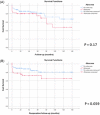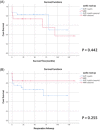Surgical outcomes and optimal approach to treatment of aortic valve endocarditis with aortic root abscess
- PMID: 35384049
- PMCID: PMC9321057
- DOI: 10.1111/jocs.16464
Surgical outcomes and optimal approach to treatment of aortic valve endocarditis with aortic root abscess
Abstract
Objectives: To evaluate the impact of aortic root abscess (ARA) on the postoperative outcomes of surgically managed infective endocarditis (IE) and to inform optimal surgical approach.
Methods: Between 2009 and 2020, 143 consecutive patients who underwent surgical management for aortic-valve IE were included in a retrospective cohort study. Multivariable and propensity-weighted analyses were used to adjust for demographic imbalances between those without (n = 93; NARA) and with an ARA (n = 50). Additionally, empirical subgroup analysis appraised the two most used surgical techniques; patch reconstruction (PR) and aortic root replacement (ARR).
Results: Demographic characteristics were similar between ARA and NARA except for logistic EuroSCORE, previous valve surgery, and multivalvular infection. In-hospital mortality was 8% and 12% in NARA and ARA, respectively (p = .38), with mortality rates consistently nonsignificantly higher in ARA across all time periods. The overall reoperation rate was also higher in ARA (27% vs. 14%; p = .09) and ARA was shown to be associated with late reoperation (odds ratio [OR] = 2.74; 95% confidence interval [CI] = 1.18-6.36). Patients treated with an ARR showed a 16% increase in late mortality when compared with PR (40% vs. 24%; p = .27) and a 17% lower reoperation rate (14% vs. 31%; p = .24). Propensity-weighted analysis identified ARR as a significant protective factor for reoperation (hazard ratio = 0.05; 95% CI = 0.01-0.34).
Conclusions: The presence of an ARA in aortic valve endocarditis was not associated with significantly higher early and late mortality but is linked with a higher reoperation rate at our institution. ARR in ARA is protective from reoperation so should be considered best practice in this setting.
Keywords: aortic root abscess; aortic root replacement; infective endocarditis; patch reconstruction.
© 2022 The Authors. Journal of Cardiac Surgery published by Wiley Periodicals LLC.
Conflict of interest statement
The authors declare no conflicts of interest.
Figures



Comment in
-
Surgical outcomes and the optimal approach to the treatment of aortic valve endocarditis with an aortic root abscess.J Card Surg. 2022 Jul;37(7):1926-1927. doi: 10.1111/jocs.16465. Epub 2022 Apr 2. J Card Surg. 2022. PMID: 35366016 No abstract available.
-
Optimal surgical strategy for those with aortic valve endocarditis and aortic root abscess.J Card Surg. 2022 Aug;37(8):2510. doi: 10.1111/jocs.16623. Epub 2022 May 19. J Card Surg. 2022. PMID: 35589560 No abstract available.
References
-
- Cahill TJ, Baddour LM, Habib G, et al. Challenges in infective endocarditis. J Am Coll Cardiol. 2017;69(3):325‐344. - PubMed
-
- David TE, Regesta T, Gavra G, Armstrong S, Maganti MD. Surgical treatment of paravalvular abscess: long‐term results. Eur J Cardiothorac Surg. 2007;31(1):43‐48. - PubMed
-
- Varela Barca L, Navas Elorza E, Fernández‐Hidalgo N, et al. Correction to: Prognostic factors of mortality after surgery in infective endocarditis: systematic review and meta‐analysis. Infection. 2019;47(6):897. - PubMed
-
- Baumgartner FJ, Omari BO, Robertson JM, Nelson RJ, Pandya A, Milliken JC. Annular abscesses in surgical endocarditis: anatomic, clinical, and operative features. Ann Thorac Surg. 2000;70(2):442‐447. - PubMed
-
- Naqvi TZ, Boyatt J, Siegel RJ. Predictors of mortality in paravalvular abscess. J Am Soc Echocardiogr. 2005;18(12):1404‐1408. - PubMed
MeSH terms
Grants and funding
LinkOut - more resources
Full Text Sources
Medical
Research Materials

